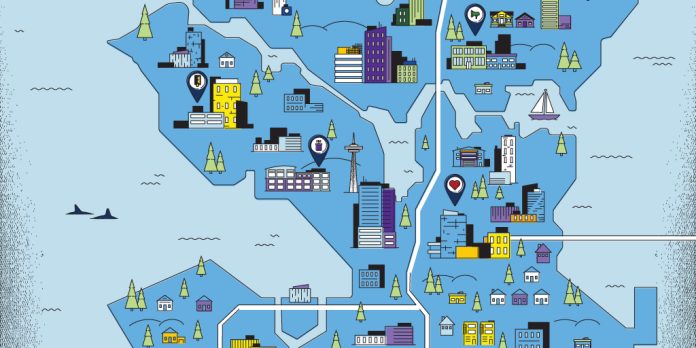Under new rules that started this month, early community engagement will be a key element of Seattle’s design review process. Policymakers hope that the change will get developers and community members talking to each other before the formal design process begins and result in outcomes where proposals better reflect community values and priorities.
While there are many development firms out there that have been voluntarily working with community groups and boards like the Pike/Pine Urban Neighborhood Council and Roosevelt Neighborhood Association to get community feedback, not all do. So often in the design process, developments move to local design review boards where the proposals are seen for the first time and are well set in their direction having had little or no community feedback. At that point, it is difficult to dial things back to address foundational community priorities and issues that are not directly related to architectural and site design issues, the kind of things that are usually outside the purview of city design guidelines and local design review boards.
New Community Engagement Framework
The new early community engagement framework, which is jointly managed by the Seattle Department of Construction and Inspections (SDCI) and Seattle Department of Neighborhoods (DON), requires applicants with projects participating in the design review process to develop early community engagement plans and then execute them in their local neighborhoods. The new framework started on Sunday (July 1, 2018) and applies to all projects submitted for Early Design Guidance (EDG) on or after that date.
The first major milestone that developers will need to achieve in the new framework is development of a community engagement plan, which must include a mix of printed, digital, and in-person mediums to obtain community feedback. At least one “high-impact” method or two “multi-pronged” methods from each of the three medium types must be used as part of individualized community engagement plans. The general options available to developers are as follows:
Community Engagement Methods
| Outreach Type | Method Type | |
|---|---|---|
| High-Impact | Multi-Pronged | |
| Printed | Door-to-door fact sheet or flyer distributed to residences and businesses within approximately 500 feet radius of the proposed site | Ad or article in local print newsletter |
| Posters hung in a minimum of 10 local businesses, community centers, or other publicly-accessible venues, located within approximately a half-mile from the proposed site; at least half of the posters must be visible from the sidewalk | Sign(s) on-site that are visible from sidewalk | |
| Direct mailings to residences and businesses within approximately 500 feet radius of the proposed site | ||
| Ditigal | Online survey | Basic project webpage |
| Project hotline (information and voicemail) | Email to distribution list that includes community organizations identified by DON | |
| Interactive project website with public commenting function | Post on local blog or in digital newsletter that includes information on how to submit comments directly to the project applicant | |
| In-Person | Focus group open to representatives of community organizations identified by DON | Drop-in hours at business, community center, or other venue near site |
| Guided tour or site walk | Staffed "pop-up" event near site | |
| Hosting or co-hosting a community meeting (at least one-hour presentation and discussion of project) | Table at community event or festival | |
| Presentation at an established community organization (at least 20 minutes on agenda) | ||
| Door-to-door visits/canvassing and businesses within 500-foot radius of the proposed site |
The framework provides additional specificity for the minimum requirements of each medium type.
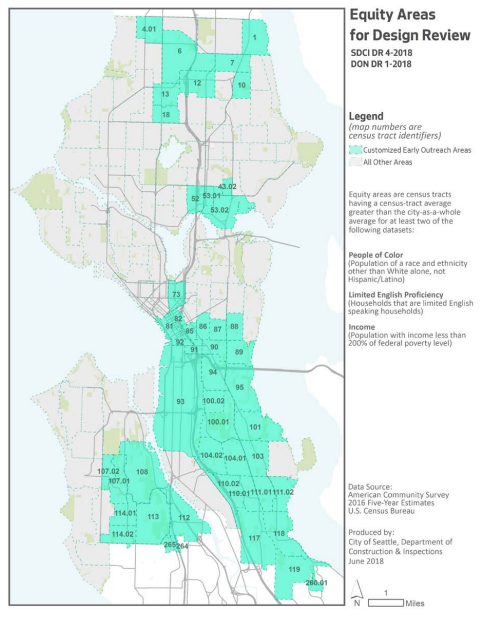
In addition, developers looking to build in certain census tracts, known as “equity areas,” will be required to work closely with DON to create tailor-made community engagement plans that use alternative outreach strategies. Equity areas have one or more of the following characteristics: higher than average populations with people of color, low-income (below 200% of the poverty line), and low English proficiency as compared to the city as a whole. The purpose of this is to ensure that outreach in historically underrepresented communities matches the unique attributes of the communities, such as communication in native languages and targeted means of reaching community groups.
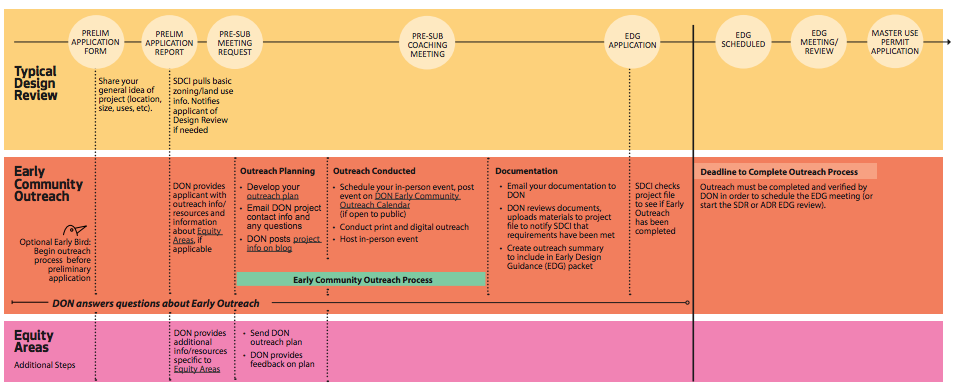
In terms of process and timing, community engagement plans will need to be approved by DON prior to formal outreach to community. Once that has been accomplished, the developer can implement the community engagement plan to solicit local feedback to their conceptual project. Comments received must be captured by the developer (e.g., the development firm’s staff, architect, or professional outreach team) and then fully and accurately synthesized. Those comments must be transmitted to SDCI prior to scheduling of the first EDG meeting for a project. All community engagement must occur no more than one year prior to submission of an EDG application.
Making It Easy To Do
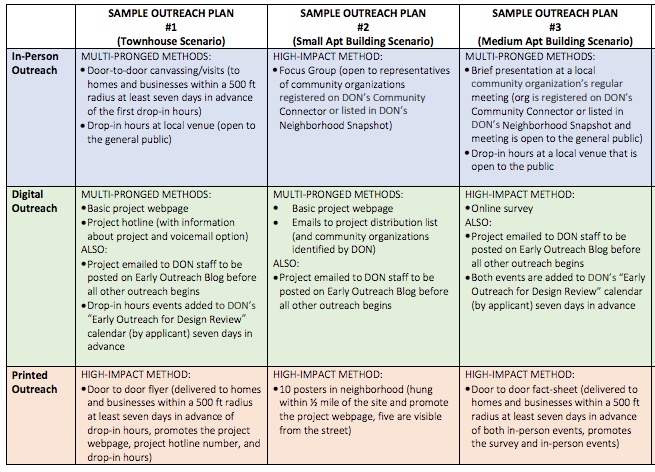
DON has tried to make the process for community engagement easy and cheap for applicants. A centralized, special website has been purpose built for the program, serving both community and applicants. The website highlights various aspects of the program and resources, including:
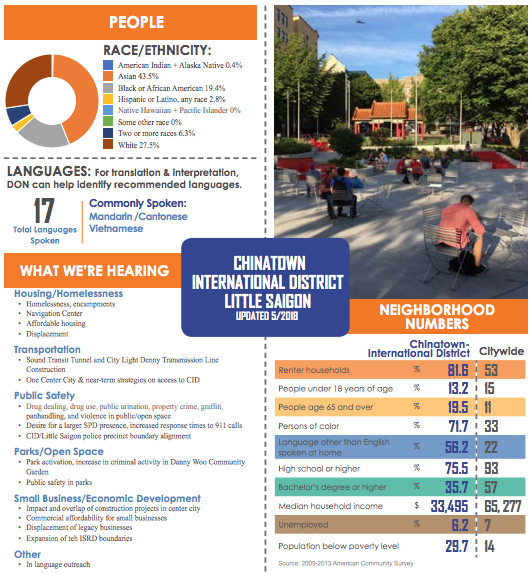
- Detailed sample community engagement plans;
- Resources to find public meeting space;
- A free calendar to highlight early outreach community meetings;
- A search tool to find various community groups across the city to engage;
- General facts about the program;
- Examples of developer presentations;
- Snapshots of community attributes;
- A blog featuring all new projects participating in the early community outreach program with basic information (e.g., project contact, location, project type, and general scope of proposal); and
- A link to the SDCI design review program webpage, which provides background on the program, design review guidance, and information about projects proceeding through the process.
Developers will also have access to the expertise of DON to help them through the process and make the early community engagement framework work for them regardless of the size of their project and where they plan to do it. The overarching objective of the system that DON has put together is to make the process as painless as possible for developers while providing a useful framework for community to interact constructively with developers.
Outlook of the Early Community Engagement Framework
There are high hopes that the early community engagement framework will result in better projects that reflect community values and priorities. But there are no guarantees that will happen program-wide. The early community engagement framework is just one step in the design review process and one that has no real regulatory teeth. While developers will be required to seek and record feedback from community, developers are not obliged to change their intended design in response to community feedback prior to submitting for EDG. So there should be some caution in setting too high of hopes. Still, to go through that process to hear from people and not try to take cues from and respond accordingly to some of that feedback will probably be the exception, not the norm. New projects operating under the new framework in the next few months should be good test cases in whether or not the program is operating as intended.
Stephen is a professional urban planner in Puget Sound with a passion for sustainable, livable, and diverse cities. He is especially interested in how policies, regulations, and programs can promote positive outcomes for communities. With stints in great cities like Bellingham and Cork, Stephen currently lives in Seattle. He primarily covers land use and transportation issues and has been with The Urbanist since 2014.


